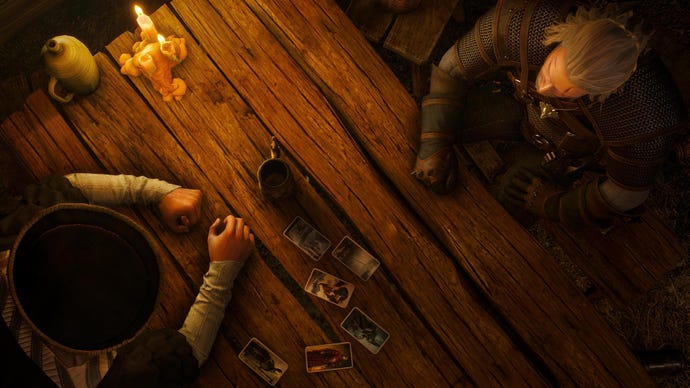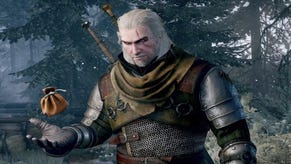The Witcher 3: Blood and Wine - beating the Skellige Gwent set
Gwent gets serious in Blood and Wine.
The Witcher 3: Blood and Wine - beating the Skellige Gwent set
At launch, the hardest quest of The Witcher 3: Wild Hunt was Collect 'Em All. Despite the notorious difficulty of this series, no boss nor monster was anywhere near as impenetrable a barrier to that platinum trophy than an easily-missed card or a tough Gwent duel.
That has all changed now; CD Projekt RED has patched in a book to help you track down missing Gwent cards, and alternate routes to cards previously lost forever. As long as you know how to kick ass at Gwent, you'll have no problems in Wild Hunt.
Blood and Wine, however, is a whole different story. Level 49 monsters got nothin' on a random shopkeeper with a set of Shield Maiden cards.
Never Fear, Skellige's Here
The second expansion to The Witcher 3 introduces a whole new deck - Skellige - and it may give pause even to hardened card sharps who laugh in the face of Nilfgaard's Spies and the Monster deck's Musters.
Combining the best aspects of multiple factions with all-new abilities, the Skellige deck has several notable features:
- Bonds
Warships (siege) and Shield Maidens (melee) will double (or triple) their attack strength when played in groups of two (or three).
- Muster
Longships (ranged) have low attack but playing one means all the others in the draw pile join the fun. Very rarely encountered singly; most players have two and many have three.
- Cow and Kambri
Both are examples of a new card type with no attack power, but which will be replaced by powerful unit card whenever it is removed from the board - including at the end of a round. If there's one on the board when a round ends, the replacement is added at the start of the next round.
- Mardroeme and Berserk
These two new card types work together. Mardrome played on the same row will turn weak Berserk cards into powerful Bear cards. Bear cards have Bonds.
- Crach an Craite
This leader card shuffles the graveyard back into the draw pile. That means you can't use Medic to retrieve fallen units, which is horrifying the first time you encounter it. Worse, all those Musters and Bond cards can and will come back.
- Deck special ability
If a match runs to three rounds, two cards will be drawn and played from the Skellige graveyard. If Crach an Craite's ability has not been used this can mean a world of hurt. It's especially painful if you've been relying on Spies; your opponent may end up with four extra cards, and if any of those have a Muster on them, you're in trouble.
- Cerys an Craite
The hero card Cerys has been updated with Muster (Shield Maidens). This can add up to 46 to an attack row in a single move, increasing to 82 with Commander's Horn.
- Emrion
The hero card Emrion has been updated with Mardrome.
Strategies
Playing against Skellige is tough and somewhat dependent on luck; a good draw is absolutely key. Players with full Gwent collections will have a much easier time than those jumping straight into the expansion or beginning Gwent for the very first time.
You can't rely on your old strategies, either. Throwing rounds is mush riskier against a Skellige player - they'll auto-play two extra cards to start the third round. It's certainly not impossible to win in the third round, but you can not rely on exhausting your enemy's deck for an easy third round win as you can with most other decks.
Having been somewhat over-powered in the original meta, Spy and Medic cards meet their match in the Skellige deck; there are just so many ways for a Skellige player to foil them. Crach an Craite can empty your graveyard, ruining a Medic plan. The Skellige special ability can turn your own spies against you, if you're unlucky. Multiple Muster and Bonds cards mean even a small Skellige hand is deadly enough to overpower a brimming opponent's hand.
So that's three of our favourite tricks downgraded from reliable winning strategies to risky gambits. This only makes it more fun when you pull it off, of course - but it's important to keep your deck and your hand open to multiple tactics, rather than choosing an approach ahead of the match start, as you usually can when facing other factions.
Scorch and the Villentretenmerth unit card really come into their own here; if you've got 'em, fill your deck. You can't rely on them to take out Muster sets for good, because cards in the Skellige graveyard are as good as cards on the table in round three, but they're excellent for cutting holes in your opponent after they've passed a round and are confident in a victory.
If you're having trouble with a Skellige opponent and have a full Gwent collection, one pretty wild strategy is to fill your deck with as many Scorch and Villentretenmerth cards as you can, and then fill out the ranks with some of the most p**s-weak cards you can find. When your opponent passes on your play of weak little cards, Scorch them to heck and take the round. The AI will generally let you do this more than once; nobody ever expects a second Scorch.
Practice Makes Perfect
Ultimately, the Skellige deck is an excellent addition to Gwent as it provides a marvellous counter to all the too-easy tricks you've been using on the AI up till now. Playing against Skellige feels like playing against yourself: sudden last minute power plays and game-changing turnabouts.
To beat Skellige players you'll need to be flexible, and even if you had no problems in the core game you will lose a few times while you adapt to the new balance. Practice is essential before you hit up the tournament or go after unique cards.
Luckily, CD Projekt RED has provided. Once you have progressed through the Blood and Wine storyline far enough you'll unlock your own little estate. Visit it and get to know your majordomo, and after a round of renovations he'll be willing to play with you.
The majordomo has every card in the game at his disposal, and you can choose nominate deck you want to play against (or ask to be surprised). There are no cards or money to be won from this, but it's great for testing your decks and tactics against a high-level opponent.










